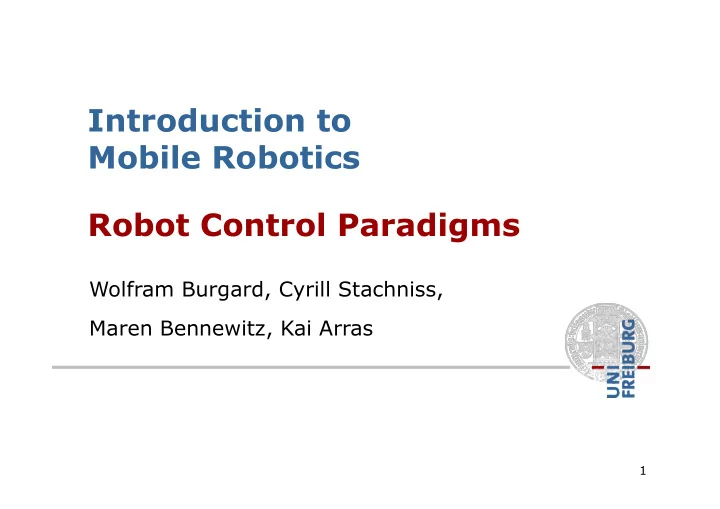

Introduction to Mobile Robotics Robot Control Paradigms Wolfram Burgard, Cyrill Stachniss, Maren Bennewitz, Kai Arras 1
Classical / Hierarchical Paradigm Sense Plan Act § 70 ’ s § Focus on automated reasoning and knowledge representation § STRIPS (Stanford Research Institute Problem Solver): Perfect world model, closed world assumption § Find boxes and move them to designated position 2
Stanford CART ‘ 73 Stanford AI Laboratory / CMU (Moravec) 3
Classical Paradigm Stanford Cart 1. Take nine images of the environment, identify interesting points in one image, and use other images to obtain depth estimates. 2. Integrate information into global world model. 3. Correlate images with previous image set to estimate robot motion. 4. On basis of desired motion, estimated motion, and current estimate of environment, determine direction in which to move. 5. Execute the motion. 4
Classical Paradigm as Horizontal/ Functional Decomposition Motor Control Perception Execute Model Plan Sense Plan Act Sensing Action Environment 5
Reactive / Behavior-based Paradigm Sense Act § No models: The world is its own, best model § Easy successes, but also limitations § Investigate biological systems 6
Reactive Paradigm as Vertical Decomposition … Explore Wander Avoid obstacles Sensing Action Environment 7
Characteristics of Reactive Paradigm § Situated agent, robot is integral part of the world. § No memory, controlled by what is happening in the world. § Tight coupling between perception and action via behaviors. § Only local, behavior-specific sensing is permitted (ego-centric representation). 8
Behaviors § … are a direct mapping of sensory inputs to a pattern of motor actions that are then used to achieve a task. § … serve as the basic building block for robotics actions, and the overall behavior of the robot is emergent. § … support good software design principles due to modularity. 9
Subsumption Architecture § Introduced by Rodney Brooks ’ 86. § Behaviors are networks of sensing and acting modules (augmented finite state machines AFSM). § Modules are grouped into layers of competence. § Layers can subsume lower layers. § No internal state! 10
Level 0: Avoid Polar plot of sonars Turn Feel force Run away force heading heading polar Sonar encoders plot Forward Collide halt 11
Level 1: Wander heading Wander Avoid force modified heading s Turn Feel force Run away force heading heading polar Sonar encoders plot Forward Collide halt 12
Level 2: Follow Corridor distance, direction traveled Stay in Integrate Look middle heading to middle corridor s Wander Avoid force modified heading s Turn Feel force Run away force heading heading polar Sonar encoders plot Forward Collide halt 13
Potential Field Methodologies § Treat robot as particle acting under the influence of a potential field § Robot travels along the derivative of the potential § Field depends on obstacles, desired travel directions and targets § Resulting field (vector) is given by the summation of primitive fields § Strength of field may change with distance to obstacle/target 14
Primitive Potential Fields Uniform Perpendicular Attractive Repulsive Tangential 15
Corridor Following with Potential Fields § Level 0 (collision avoidance) is done by the repulsive fields of detected obstacles. § Level 1 (wander) adds a uniform field. § Level 2 (corridor following) replaces the wander field by three fields (two perpendicular, one uniform). 16
Characteristics of Potential Fields § Suffer from local minima Goal § Backtracking § Random motion to escape local minimum § Procedural planner s.a. wall following § Increase potential of visited regions § Avoid local minima by harmonic functions 17
Characteristics of Potential Fields § No preference among layers § Easy to visualize § Easy to combine different fields § High update rates necessary § Parameter tuning important 18
Reactive Paradigm § Representations? § Good software engineering principles? § Easy to program? § Robustness? § Scalability? 19
Hybrid Deliberative/reactive Paradigm Plan Sense Act § Combines advantages of previous paradigms World model used for planning § Closed loop, reactive control § 20
Discussion § Imagine you want your robot to perform navigation tasks, which approach would you choose? § What are the benefits of the behavior based paradigm? 21
Recommend
More recommend